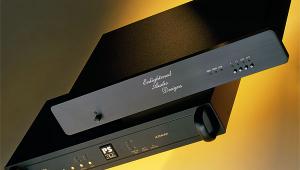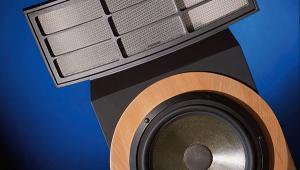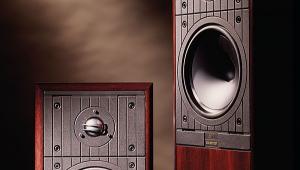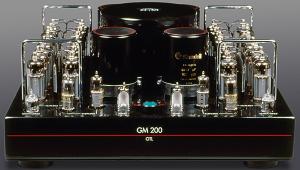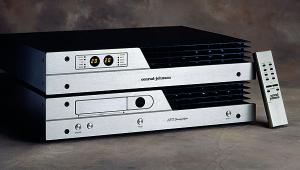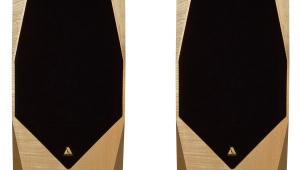Class Distinction Page 2
The system I put together consisted of the AR turntable with the excellent Mission 774 LC arm, Ortofon's jolly good MC10 Super MC cartridge (now with high-enough output to work with 'normal' MC stages), and Goodmans LS3/5As, for a total cost of around £800, including the PM-4. Though I did feed £2000 worth of Oracle turntable with Zeta tonearm and Sumiko Talisman Alchemist MC cartridge into the PM-4 just for a giggle, I don't ever want to be responsible for suggesting such an unbalanced system. I'm not of the school that says a £400 deck through a transistor radio sounds better than a proper system with a lesser deck.
I was more than pleasantly surprised. Indeed, I was thrilled with the overall results. But only when using the PM-4 in Class A mode. To be fair, the amp sounded OK in Class AB, but rougher around the edges than in Class A. There was a noticeable shrinking of the soundstage, especially fore-and-aft, and the treble took on a gritty quality that aggravated the Goodmans LS3/5As much in the way that most budget transistor units would.

When used with Marantz's £90 wonders, the LD-20 speakers, their less-revealing nature made the minor misbehaviour less noticeable. But the PM-4 never existed to steal sales away from Class AB designs, so I pushed the button on the fascia and spent the rest of the time with it in the mode for which it does exist. And I was pleased to find that it was hardly the gutless baby that one or two critics had described.
To The Edge
Okay, so LS3/5As aren't exactly Stax ESL-F81s in their power demands, but they do need some juice if you want to make any reasonable noises. A 15ohm load, they like to see amps rated at about 50W – but no more – into their terminals. The 15W of the PM-4 not only drove them to the levels I prefer (around the low 80dB mark at two metres) without any difficulty, it could and did drive them to the edge of discomfort. What's more, the bottom end was the best I'd ever gotten out of the LS3/5As in terms of extension and control. And I never got it to clip.
Maybe this is a peculiar synergy, and I can only point to the fact that I could overdrive the unit in Class A mode with speakers like the Radford T90s, which feel no pain when fed 100W. My advice is the advice any intelligent dealer would have given: if you fall for the sonic charms of the PM-4, pair it with a high-sensitivity speaker of real worth.
The list starts with the Tannoy Mercury and moves on to the current crop from B&W, Mordaunt-Short, Wharfedale, Celestion, and others... none of which were available when this amp was in the shops. Which goes back to what I said about it being ahead of its time, and not just because it jumped the gun on the popularising of Class A.
Fast 'N' Smooth
Those sonic merits are one hell of a temptation, too, enough to seduce you away from whatever 84dB-per-watt design you might have been coveting. The sound is silky and lucid, but I don't want to get into imagery involving mountain streams and limpid pools. And if I start talking about how it reminds me a bit of valve amplification I'll either be accused of rampant monomania, or have to answer to JA who keeps on asking me why I don't get a Krell. Anyway, the valve-ishness of the PM-4 is limited to warmth, by which I mean it displays an absence of clinical, over-hard edges.

The PM-4 belies its size and price by being exceptionally fast, smooth, and controlled, all of which are refinements or virtues that one expects to pay over £300 to acquire. It's the presence of these virtues that inspire remarks like 'a taste of the high-end at low-end prices'. But notice that I said a 'taste', not a three-course dinner.
What keeps the PM-4 from being that mythical £3000-amplifier-for-a- tenth-of-the-price is not just its lack of suitability with esoteric (that means power-hungry) speakers. No, the low output isn't what keeps the PM-4 from being a low-cost ticket to the state-of-the-art. It has other sonic limitations, minor enough to be academic, but important enough to distinguish it from amps costing four figures or more.
Take the soundstage. While it easily matches the best sub-£500 integrated amplifiers I've tried, it lacks that final amount of 'air', that sense of space which distinguishes the brilliant from the merely superb. But bear in mind that I'm playing dirty with the PM-4 – talking about it in cost-no-object terms as did reviewers of the Naim NAIT when that amp first appeared. Think about the implications: a £300 solid-state integrated amplifier from Japan(!) showing more in common with the very best than with the merely average. lt calls for an analogy… or shall we make that three.
Imaginary System
If the Krell is a Ferrari 512BB 'Boxer', then the PM-4 is a Ferrari 308GTB. If the Krell is Concorde, then the PM-4 is a Lear Jet. If the Krell is a full-grown cheetah, then the PM-4 is at least its cub. The Marantz PM-4 is simply small-scale high-end, the way that the Ferrari 308 is a small scale Boxer. It loses out to the big 'un in terms of absolutes, but it will shine if not asked to do more than is reasonable. And it leads me towards an imaginary system for those of us who crave the kind of set-ups that are way beyond reach, satisfying the less well-heeled the way that a Golf GTi satisfies the guy who wants, but can't afford, a Porsche.
Take a record deck such as the AR or the new Thorens TD320, an arm like the Rega, and a super but affordable cartridge such as the Denon 103. Feed this into the PM-4. Add one pair of Magneplanar SMGa loudspeakers. The result is a pint-sized version of true high-end. The cost? Under £1300, or even less than what I put together at the end of my review of the PS Audio preamp in the April issue. You will near-as-dammit duplicate in miniature a £5000 system for the cost of that killer system's front-end, provided you use this system in a room smaller than the near-auditoria required by big speakers of the MGIII/Apogee/Quad 63 persuasion. And even if funds aren't a limiting factor, but room-size is, then this could be your answer.

If I've gone over the top in describing the ultimate virtues of the PM-4, it's only because I didn't ask it to do anything that is prima facie beyond its design parameters. I did not ask it to provide 110dB signals from inefficient speakers in a room the size of the Virgin Megastore. I did not ask it to take a low-output MC cartridge via its MM inputs. I only asked for it to turn highly regarded, affordable components into a system above reproach for it's total cost.
Move Quickly
Which brings me back to the ulterior motive, which in retrospect isn't ulterior at all. At first, when I heard that Marantz had uncovered 100 unused PM-4s in one of the European warehouses, I figured 'Oho! Old Steve Harris wants us to do the selling for him'. Then, after I'd lived with the piece for a few weeks and learned that Marantz was knocking £50 off the price, I could only look at the whole operation as some kind of godsend for those who crave the esoteric but lack the necessary means.
These beauties turning up a year after they ceased production, in pristine, virgin form, is akin to your local record shop finding a box of sealed copies of Mercury 'Living Presence' LPs and selling them off at £4 each. First come, first served.
So... the Marantz PM-4, at £249, is one of 1985's genuine hi-fi bargains – if not a total steal – for the 100 lucky shoppers who find the limited number of Marantz dealers to whom they've been offered. I learned, just before sitting down to type this, that the number is now down to 80. Move quickly – if not to buy then at least to listen.
I'm buying one.










